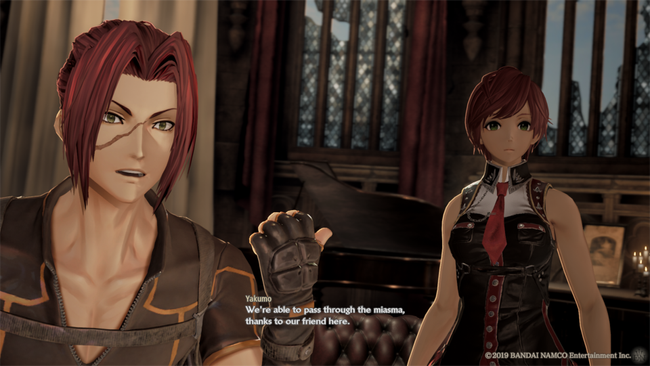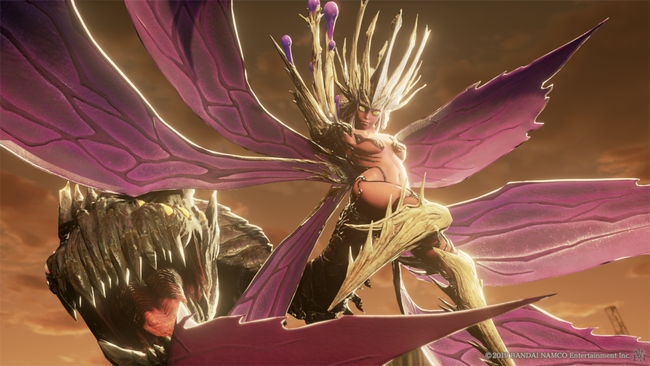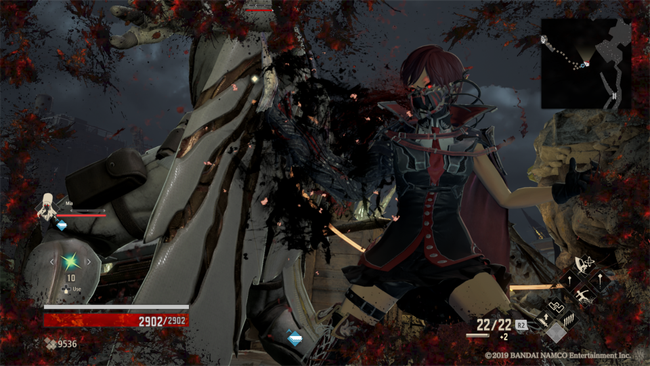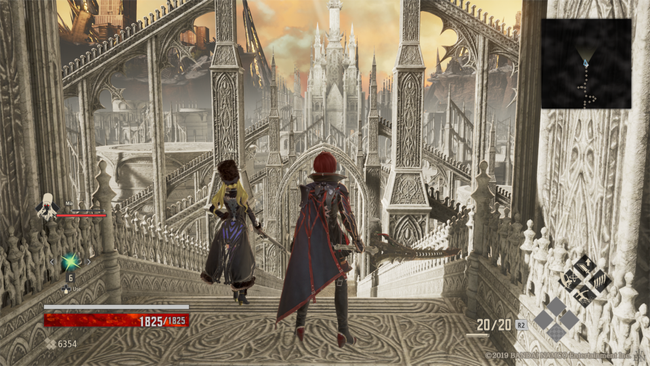Code Vein Review
It’s impossible to deny that the success of Dark Souls has changed videogames. It might not be a “genre” per se, but we have already begun to see several games perhaps best labeled as a “Soulslike” developed by studios other than From Software. None of these games have reached the same status as Dark Souls, even if some did find their own audiences thanks to their own take on this style of RPG. The more unique ones, willing to separate themselves as much as they can while still being recognizably influenced by Dark Souls, are the most memorable. Code Vein, unfortunately, is not one of those.
Developed by the team behind the God Eater series, Code Vein has been casually dubbed since its announcement as “anime Dark Souls”. That description, seemingly superficial and not exactly very descriptive, ends up being an apt way to summarize what Code Vein is. Just one look at the game, especially its character designs, is enough to see that Code Vein is going for a very unique gothic style of anime in order to try and bring its own flavor to the Dark Souls formula. To separate itself from its influence even further, Code Vein also attempts to put a heavy emphasis on its narrative, though this ends up being one of the game’s weakest points.

Your character is a Revenant, a being that once was human but now can’t die as long as their heart is unharmed. Revenants were created using a parasite in order to fight a mysterious Queen, another Revenant that frenzied after an event known as The Great Collapse. A Revenant goes into a frenzy after spending a long time without consuming human blood, and if that happens, they can become monstrous creatures known as the Lost.
Years after the defeat of the Queen, the city where the Revenants live is surrounded by a mist that prevents them from escaping. Few humans remain, and under the control of the government, they are forced to donate blood. Rare fruits called blood beads have started sprouting that can serve as a replacement for human blood, but these too tend to be regulated by the government. It’s a potentially interesting setting for a post-apocalyptic story on paper, but it remains largely shallow and never really engages in-depth with the many subjects that the plot plays around with.
Instead, the main plotline ends up a very generic “save the world, chosen one” type of story. Your character, for reasons that are barely explained, has many different powers that just happen to be what is needed to try and cure Revenants once and for all. As such, you are recruited by a crew of Revenants that are investigating a way to save your kind, but since your character is a silent protagonist, you end up being just a glorified tool to advance the plot. Not all characters in the game are particularly interesting, but all of them have more going on than the protagonist who is somehow a friend loved by everyone and the most important person in the universe despite being only capable of grunting in combat and has zero personality. Soulslike tend to have silent protagonists and it works for them, but if Code Vein wants its story and character interactions to be one of its main draws then having a silent protagonist ends up being a huge misstep.

One of the powers your character has is the ability to access memories lost by Revenants. When one of them dies and comes back, a Revenant leaves behind a vestige with a memory that they forget, and your character is the only one capable of restoring them. This is how you get the backstory of your crew and some other key characters, but while these scenes are interesting visually (using silhouettes and only a few colors), the content is bland and mostly tries to make you care for its characters by way of them all having tragic stories. Simply gesturing at things like abuse, slavery or human experiments isn’t enough if a game is not willing to engage with those themes in the meaningful ways they deserve.
But if I’m going to talk about themes that deserved better, I have to mention the game’s treatment of women, which leaves a lot to be desired. Most women in Code Vein are either being protected or being rescued by men. Most of them have designs that would make other anime games seem prude in comparison, with even female enemies and bosses having breast physics that make no sense. The worst case is your companion Io, an amnesiac girl who spends most of the game acting infantilized as many anime women do, with breast physics so ridiculous that even the wind in the intro cutscene in the game can move them.

Setting aside its writing and characterization, Code Vein tries to change the Dark Souls formula with quite a few gameplay differences. Yes, you have a good number of weapon types, a stamina bar, the equivalent of a bonfire that respawns enemies and lets you level up your character, Haze that works exactly the same as Souls do (as currency and experience), backstabs, lock-on, online multiplayer and more similarities. However, Code Vein tries to shake things up by adding skills and classes in a different way - unique for these types of games.
Your character can equip a Blood Code, which is essentially the game’s name for its class system. Each Blood Code provides different stats and a variety of skills called Gifts, both active and passive, that you can buy by spending Haze. You can equip up to four passive Gifts and 8 active ones that you can use by spending Ichor (the game’s equivalent to MP) which you recover by attacking or using drain attacks that are different for each type of armor you wear. Every Blood Code also has certain Gifts that, if you defeat enough enemies while equipped with them or spend some upgrade materials, you can inherit them with any other Blood Code. On paper, this system should allow for an ample variety of builds. The execution, however, made me feel rather limited in the Gifts I could use.
The main problem is that when you level up, you are only increasing your base HP, stamina and attack numbers. Everything else, be it Strength, Vitality and other typical values for these kinds of games, is dictated by your Blood Code. Every Blood Code has a different arrangement of stats and with around 24 different Blood Codes to choose from, that means you have 24 different configurations of values you have to pay attention to, making it unnecessarily convoluted. What’s more, every weapon, armor and almost every Gift requires a certain value of one or more stats which inevitably means that despite the game explicitly telling you otherwise, not every Blood Code can use every Gift or piece of equipment.

For example, my personal build used one early Blood Code that favored one-handed swords. I stuck with it because one of its Gifts, which increased attack with swords after each consecutive hit, was not a Gift that could be inherited. As such, I looked to other Blood Codes for Gifts to inherit to compliment my playstyle. I immediately noticed that you have no way of knowing if a Gift is inheritable or not without first spending the Haze to buy it. I bought one that would raise a barrier that reduced damage taken (you also can’t see them in action until you buy them, you only have a short sentence of description as a guide) without checking that it required higher Vitality than what my Blood Code offered, something that you also can’t compare from the menu you buy them from. Without any way to upgrade my Vitality stat on demand, I ended up wasting that Haze in a Gift I couldn’t use because I didn’t want to ditch my sword Gifts. There are many ways to play these kinds of games, and this was my own experience with it, but if the game’s most unique system made me feel restricted instead of compelled to experiment, then something within the system needs more work.
The combat itself is largely what you can expect out this type of game. You have a light and a heavy attack, and you need to look for an opening in your enemies’ attacks by either blocking, parrying or dodging. Code Vein, however, also offers different AI partners each with their own playstyle that you can pick from within your crew to take with you all when exploring. While you can go alone, the game is clearly balanced with an AI partner in mind, who can properly take care of themselves most of the time. Enemy variety is ample enough and most bosses offer decently balanced challenges (except for a few ones that are quite frustrating), but they’re nothing to write home about.

What definitely is worth mentioning is the level design, although not for good reasons. One of the key elements in Soulslike games is exploration. No game needs to have such a carefully interconnected world like Dark Souls, but areas that invite you to explore every nook and cranny are a must in order to make a good Soulslike. Unfortunately, Code Vein has some of the worst level design I have experienced in any Soulslike. Part of this is because areas are either mostly linear or confusingly long and labyrinthine and because, outside of the theme of the area (the snow level, the fire level, and such), every level has little variety and few if any visually effective landmarks. You can, and probably will, get absolutely lost in some of those areas even considering that Code Vein has a map that just doesn’t work as intended because it’s too small and you have no control over it.
This absence of visual flair in the levels is in a way an indication of the lack of confidence Code Vein gives in its visual style, which is perhaps one of the most surprising things about the game for me. In a game that you can describe as “anime Dark Souls” where everyone is a goth vampire and the music is full of overly dramatic choirs, you have surprisingly very little options for visually customizing your character. Your clothing is very limited and even then, the armor you wear, which are different varieties of capes, almost always cover whatever you chose for your top and are not particularly interesting in design. What’s more, in a game like this, you will mostly wear them for stats rather than style.

There’s a specific cutscene near the middle point of the game that perfectly represents what Code Vein could’ve been. After a failed and unearned attempt at an emotional reveal involving barely developed characters and yet another almost naked woman with zero agency, your group is ambushed by a couple of characters that you’ve seen doing bad things a few times already. Then, all of a sudden guitars start playing, and all of you fight in an actually well-choreographed scene to the tunes of Japanese rock band Vamps turning the cutscene into something that wouldn’t feel out of place in, for example, a game like Devil May Cry.
After the scene was over, I was left asking myself just where was this Code Vein hiding. That cutscene showed a confidence in its style and personality that isn’t found anywhere else in the entire game. If it leaned more into the aspects that could make Code Vein truly unique, just like that cutscene did, the game would be much more appealing. As it is, it’s hard for Code Vein to stand out in a group of games that have attempted to be more than just a Soulslike. With good ideas in terms of gameplay that are poorly executed and interesting themes that go completely unexplored, Code Vein ends up being unfortunately just another average Dark Souls clone with a slightly different flavor that it doesn’t even try to offer in spades.